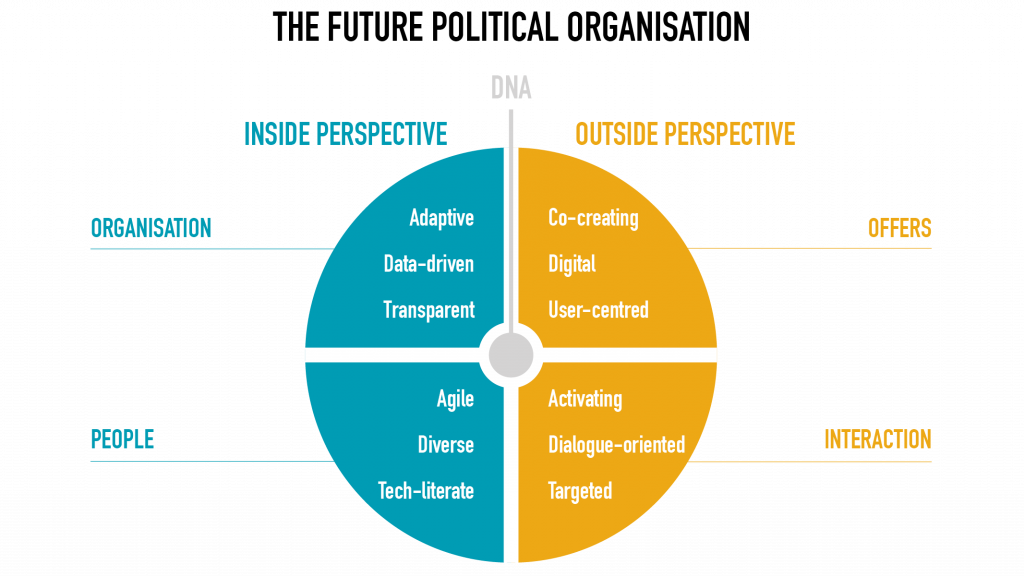This is the second part of a blog series on the political organisation of the future.
In the last blog we highlighted three key trends impacting the political sphere. We see connectedness, new work and new learning as the trends which will fundamentally change the way organisations in the political sphere operate.
In this blog we will shed light on the organisational aspects impacted by these trends. We look at the organisation of the future from three perspectives: the organisation’s DNA, its organisational design and workforce, and the way it creates offers for and relationships with citizens.

(Source: own illustration)
A value-driven and ambidextrous organisation
The political sphere is a volatile, fast-changing environment. And it does not look like things will slow down anytime soon. To successfully navigate in this environment, organisations need a purpose that guides their strategy and decision-making. And they need a set of underlying values that provide employees and leaders with general principles for how to act, communicate and make decisions.
To survive in this ever-changing environment, organisations in the political sphere need to be able to continuously renew themselves. Thus, we argue that political organisations will develop into value-driven ambidextrous organisations which possess an innovation and growth mindset of both exploiting current and exploring new opportunities to change society for the better.
Open, transparent and data-driven
In an ever-changing environment, the design of a political organisation needs to be able to adapt to new needs and circumstances. Thus, in the future, a political organisation will be able to upsize and downsize its structures, processes and scope according to new developments. This may take the form of an increased/decreased workforce, new working models and short-time teams.
Also, societies will continue to demand transparency from political organisations. Consequently, political organisations will open up in two ways: first, they will provide citizens with insights into their operations, e.g. into their finances. And second, they will be open for ideas and modes of collaboration with individuals and organisations outside their organisational boundaries.
The use cases of technological developments for organisations operating in the political sphere will also increase. Thus, political organisations will start to use data and data analytics at all stages of their value chain and enable decision-makers at all levels to make evidence-based as well as anticipatory decisions.
An agile, diverse and tech-literate workforce
To create high-quality offers, staffers need to have the mindset and skills to test ideas, improve them systematically and develop minimum viable solutions in a short period of time. In short: they need to be, think and work agile.
Also, political organisations will become more diverse and experience and increase in diversity both in staff and leadership. This refers not only to a female shift in the workforce but also as a consequence of a socially and culturally diverse society. Consequently, this forces leaders to develop strategies for managing diversity.
To make use of technological developments, people working in political organisations of the future will be tech-savvy. They will have the skills to understand technological developments, anticipate their potential for the organisation and create corresponding solutions. This also entails the skills needed to work with and manage data strategically.
Activating citizens to collaboratively develop user-centred digital solutions
The digitalisation of services and products in the political sphere has a strong impact on what political organisations can offer. Already today we see governments digitalising their services, growing opportunities to digitalise democratic processes, and startups entering the public sector with their digital solutions. Future technological developments will increase the opportunities for digital products and services, and political organisations will jump on this bandwagon to increase their performance.
To develop these new digital offers, political organisations will start to approach problem-solving by systematically sourcing the needs of users. As this reflects a shift from current practices where in-house experts set the tone, this user-centred approach will also strongly impact the organisation’s culture.
By shifting from top-down rollouts to co-creating new modes of organisational design and opening the organisation beyond its boundaries, political organisations of the future will empower citizens, users and stakeholders to develop their offers in close collaboration with them. This will happen in a broad range of fields, from government policy-development, to party manifestos, to new programmes.
To facilitate civic participation, political organisations need to strengthen their ability to use data to target citizens and meet them in their preferred channels.
Insights into the political party of the future
This second blog means to inspire readers to envision the political organisation of the future. Stay tuned for the last blog of this series in which we will look at whether the political party of the future already exists.
Sign up to our newsletter to receive upcoming insights.What are your thoughts on this blog? Did we make you think? Looking forward to hearing your thoughts!
